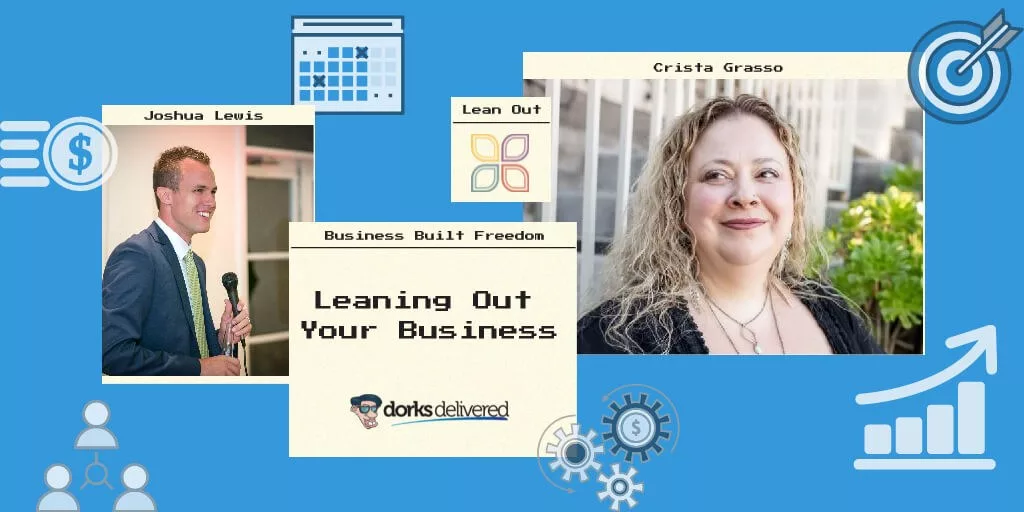One of the challenging parts of being a business owner is taking a substantial amount of time to make the best decisions for your company. It doesn’t always mean that you just flip a coin whenever you need to choose. Weighing the pros and cons is the more effective way to move forward. Being patient while using the right tools and implementing a systematic process can drive your business to its sustainability.
Many of us make the mistake of thinking that it has to be perfect by the launch date not knowing that constant running of tests, trial and error, and failures are included in the package. And preparation and consistency will help you armour your business on its way to success.
In this episode, Crista Grasso, the creator of both the Lean Out Method and the 90-Day Lean Out Planner, shares tips for leaning out to level up.
Key Points:
• How Long Is a Lean Business Plan
• Mistakes to Avoid When Leaning Out
• How Leaning Out Helps Your Business
• How to Sharpen Your Saw to Be More Efficient in Running Your Business
Are You Running a Lean Business?
How would you know if you’re running a lean mean business machine or not?
Crista: It usually comes down to whether or not you have way too much going on. Are you constantly overworked or overwhelmed?
Or are you always focused on the right things and things tend to be flowing—not that you don’t have issues because you’ll always have issues in business—but you have a high degree of confidence that you’re always working on the right things that are actually making a difference and adding value for your customers and profitability for the business. You have that clear alignment when it comes to your strategic objectives and vision. If you’re in that space, you’re already well on your way to lean.
If you’re more in a place where there’s just a lot going on and you’re not quite sure if the things that you’re doing are actually going to make the difference, drive profitability, or be things that your customers will be looking for. That’s when you know that you have a real opportunity to lean out.
How long is a lean business plan?

Crista: I’m a huge fan of strategic planning, and I always add lean practices. As a result, you are just getting crystal clear on what things are going to make the most difference so you can focus on them and just eliminate all the noise and waste in the system.
However, many people are overly prescriptive when planning. They try to plan too far into the future.
Plans are so critical. That’s why you want a long-term vision, a 90-day plan. But I also think that you need to look at what are the outcomes that we’re trying to achieve. You need to allow some flexibility and get there. With the pandemic, any prescriptive plans that you had probably got thrown out the window, but it doesn’t mean that you can’t still achieve your goals if you’re willing to be flexible and pivot, making sure that you’re directionally correct.
How long term should you be looking at? We’ve had guests on Business Built Freedom who talked about having exit strategies when you get into a business and they’re talking about 5 to 20 years into the future. How long term do you need the vision to be?
Crista: From a vision perspective, you should look as far into the future as you can. When people are starting a business, sometimes they either have this big grand vision or they have a very small vision. For my first business, I just want to make enough money to never have to have a 9-to-5 job again. My vision today was very different now that I have a big company.
At this stage, I’m absolutely thinking and looking in terms of 10 years, looking at outcomes that I want. I’m not looking at specifically how I’m going to get there every month for the next 10 years. I think that’s the key: you need to know where you’re going, what’s important, and why it’s important. That lets you make the right decisions in the short term and tactically do the right things because you’re wrapping it in that longer-term strategic plan.
Plans should also not just be for you in the business. It should also be a plan for you, your personal life, and your family. Knowing your goal lets you make sure that you can work out what you need to do to get there. Writing it down is important because you know if it’s achievable or not, and if it isn’t, you can work out what you need to change to make it achievable.
Crista: It also helps when things get tough. This year proved that sometimes things just do not go according to plan. We have seasons that are good and bad in business. When they’re not so good, it’s really nice sometimes to have that very clear vision of what you want not just for the business, but also for yourself. That helps you stay motivated, push through, keep pivoting, and be innovative.
Have more time to lean out your business, and let our dorks take care of the day-to-day business operations.
If you are a business owner who has written a list of 10 or 100 things that need to be done in your business, how can you work out the one—the golden nugget—that you need to focus on?
Crista: Get really clear on your vision. Look at three different facets.
• Where you want your business to be in the future
• How your business model matches your life and lifestyle
• What your customers are going to need and want from you
Start there, and break them down into some near-term goals. You’ll have goals for the next 90 days, and it will give you clarity on whether or not you are focused on the right things.
When you look at that next level of vision across those three facets, it gives you that kind of direction to look at things where you don’t always know everything that’s going to happen. You’ll always know if the things that you’re choosing and making decisions on are directionally correct if you have that clarity and vision.
It’s about prioritising a vision and making sure that the reason you got into the business is achieving those goals.
Balance Is Important Too
I started my first legally registered business 17 years ago, and this business has been around for 13 years. I know that I was a bit out of whack to start off with an over-focus on business. I didn’t really look at family, clients, and lifestyle. Prioritizing is important, but balance is also important to be considered when creating and executing a lean business plan.
Crista: I believe in sustainable success. When most people start a business, it’s just like what you described: things tend to be out of balance.
The nature of that emerging stage of business is that the owners are saying yes to everything. You’re wearing all the hats, and you’re naturally overworking. It’s a bit overwhelming, but it’s also really exciting because you’re building something new. It’s high energy and that’s great, but that can’t sustain.
Once you’ve moved out of that emerging stage, you know your product-market fit, who you serve, what your core offers are, and how your business actually makes money. At that point, you need to focus on leaning out and focusing much more on that balance and in that sustainable success and sustainable pace. What are all those facets of your life that are important to you aside from your business? How can you carve out and create the space for all of them and build a team to surround yourself so that you can achieve that balance and maintain it?
If your business is in its infancy, how do you balance your life? How do you know what you should be focusing on? If you’re single and you’ve got a 90-hour week, and then for whatever reason, you’re at a barbecue and met the love of your life, how do you make sure that you’re balancing without pushing your goals further into the future?
Crista: I have a time pie. We all have 24 hours in a day. Knock out the essentials—sleeping, eating, taking a shower, etc. With the hours you have left, figure out how you carve the rest of that time up. Figure out what’s important to you. Have one for a workday and another for a non-work day.
As business owners, we tend to have every day as a workday but we still have some days as non-work days. Think about balance at a macro scale, instead of a micro-scale. That is, not every single day is going to be in balance. Not every single week is going to be in balance. You’re going to have periods where you’re launching something or doing something for your personal life, and things are going to be out of balance, which is fine. But you want to look at that macro scale and try to swing it back. If you had too much going on in your business, then you really do need to carve out time for personal.
In the example where you met somebody but there are things in business that you feel are critical and you must do so you’re working 90 hours a week. All of a sudden, you realize you could have a leaner business. Maybe you didn’t really need to be doing something and you can create time to go on a date tonight. Sometimes it’s even fun to put yourself mentally in those types of scenarios to determine what you could cut if this thing that you want so badly personally came up. It could tell you which things are not actually as important for the business as you’ve thought.
Is your business at a stage where it’s best to have managed services? Talk to a dork and get a free assessment.
5 Mistakes to Avoid If You Want a Lean Business
In achieving the balance and maintaining the balance, I’m a big believer that change is as good as a holiday. But a lot of people do not necessarily feel that same way. Some think that they have been doing what they’ve been doing for ages and it’s kind of working. How do you make sure that someone is comfortable leaning out?
1. Doing Too Much
Crista: Doing too much, offering too much. When people don’t have that real clarity, they tend to have way too many products and way too many offers for way too many different customers. It can be really confusing and hard to know what the business is really known for. In turn, it ends up creating too much work for the team as well as for the business owner.
2. Focusing on the Wrong Thing
Crista: It’s not just the quantity, but it’s the things that you’re focused on. Ask: Is this the right thing? Is this the right thing right now?
3. Not Having a Strategic Plan
Crista: A lot of people have a vision, and a lot of people have a list of mile-long of things to do. It’s not common that those two things connect to one another, and they do need to connect to one another. When you’re trying to figure out what it is that you need to do, you need to make sure it’s in support of the vision and goals.
4. Not Making Decisions Based on Capacity
Crista: You need to make decisions on what you’re going to do based on the capacity you have. Many people just have this big list of stuff to do. They basically work until exhaustion, and then they pick up the next day and do it all over again instead of reverse engineering and identifying the capacity that they and their team have as well as what they can realistically do.
5. Avoiding Sunk Cost
Crista: When people have started something, they will continue working on it and finish it even if all signs point to the fact that it’s not what customers want, it’s not going to drive profitability, or it’s going to hurt the business from a profitability perspective just because they’ve sunk time, effort, and money into it. That’s time that could have been spent on something else that would be more value-added. It’s just human nature to finish something that was started, even if that’s not something that is going to be profitable once complete.
Get a set of fresh eyes and a pair of extra hands while you focus on leaning out your business. Learn more!
How Leaning Out Helps Your Business

When I first started a business, I bought a book called The E-Myth Revisited by Michael Gerber. I started writing out mission statements and business plans. Every couple of years, I go back and review those—leaning out and making decisions. Mission statements and business plans have to be in line with leaning out a business, but there are lots of different methodologies in leaning out a business. As your mission statement or business plans change, how does that reflect a business that you’ve started leaning out? How do you make sure that you’re pulling in the right direction?
Crista: One of my clients had to stop manufacturing because of COVID. They couldn’t have people in house, so they had to stop manufacturing. You would think that they would have had an absolute tank in their quarter and their performance, but they pivoted and produced masks. They kind of revamped everything, but because they were very lean, they knew exactly their capacity so they were able to pivot, adjust, and do what they needed to do in order to not only help out but also remain profitable at a time when you would have thought they couldn’t.
Leaning out can really help you, but you have to pivot and be willing to make those shifts. You just need to always go back to your long-term vision.
It’s sad that businesses have to sometimes make difficult decisions. But over the years in business, I learned that being pushed towards a hard wall gives you only one direction to go and that’s forwards. When times become tough, you work out what is the most important thing: why you are in business.
It’s definitely better to be able to have forethought hindsight and plan strategically. The lean out method allows you to focus and plan and to be a fantastic business without being pushed towards a hard wall.
Combine strategy with technology. Innovate and automate to achieve your goals!
Bonus: Why You Should Sharpen Your Saw and How
A dear friend of mine told me that going away and taking a break from your business allows you to sharpen your saw so you can easily cut down the trees as opposed to working hard to cut it down with a blunt saw and just ending up working more and more.
I went away for three weeks and there are so many things that I was not able to do. It became a monotonous routine but by going away and not doing them for a bit, I realized I didn’t need to do some of them. Going on holiday definitely makes your business more efficient.
How can you convince someone who’s in a 90-hour workweek to do that?
Crista: Before COVID, I started a planning retreat. People would come out to this luxurious location and we would plan their business. It was basically for working on their business, but I did it intentionally to encourage people to take a break. People would have time to think and reflect, and they would just come home so relaxed.
There are no in-person retreats these days, so I always encourage people to work in focus blocks. I have them carve out focus blocks for self-care, relaxation, and recharging. For example, this week, commit to a minimum of a two-hour focus block for self-care. Next week, do a minimum of a four-hour focus block for self-care. They find that they actually get much more efficient and then they start to see the benefit and it just snowballs.
The tomato timer or 25/5 timer is an invaluable tool to make sure you are focusing and then shifting focus.
The Lean Out Method

She believes that in order to take your business to the next level, you do need to lean out.
We invite everybody to join the 5-day master class, where she will walk you through how to lean out. You will learn:
• how to lean out your business
• how to level up your business
• how to combine both to really get sustainable results
By the end of the masterclass, you will have your next level vision, your 90-day plan, and your time pie.
Recommended Book: The One Thing By Gary Keller
What’s the book that changed your mindset?
Crista: The One Thing by Gary Keller is a great book about focusing.
If you enjoyed this, make sure to jump across to iTunes or Spotify. Leave us some love, give us some feedback. Stay healthy!
[module-379]





























